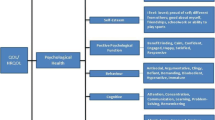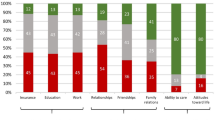Abstract
Purpose
Young adult survivors of childhood cancer (YASCC) are an ever-growing cohort of survivors due to increasing advances in technology. Today, there is a shift of focus to not just ensuring survivorship but also the quality of survivorship, which can be assessed with standardized instruments. The majority of standardized health related quality of life (HRQoL) instruments, however, are non-specific to this age group and the unique late effects within YASCC populations. The purpose of this study was to investigate the relevance and accuracy of standardized HRQoL instruments used with YASCC.
Methods
In a previous study, HRQoL items from several instruments (SF-36, QLACS, QLS-CS) were examined for relevance with a population of YASCC. Participants (n = 30) from this study were recruited for a follow-up qualitative interview to expand on their perceptions of missing content from existing instruments.
Results
Respondents reported missing, relevant content among all three of the HRQoL instruments. Results identified three content areas of missing information: (1) Perceived sense of self, (2) Relationships, and (3) Parenthood.
Conclusions
Existing HRQoL instruments do not take into account the progression and interdependence of emotional development impacted by a cancer diagnosis. The themes derived from our qualitative interviews may serve as a foundation for the generation of new items in future HRQoL instruments for YASCC populations. Further testing is required to examine the prevalence, frequency, and breadth of these items in a larger sample.

Similar content being viewed by others
Abbreviations
- YASCC:
-
Young adult survivors of childhood cancer
- HRQoL:
-
Health-related quality of life
- PTSD:
-
Post-traumatic stress disorder
- SF-36:
-
Medical Outcomes Study Short Form-36
- QOL-CS:
-
Quality of Life—Cancer Survivors
- QLACS:
-
Quality of Life in Adult Cancer Survivors
- MOS-24:
-
Medical Outcome Study Scale
- MCSCS:
-
Crown Social Desirability Scale
- UF:
-
University of Florida
References
Ries, L. A. G., Melbert, D., Krapcho, M., et al. (Eds.). (2008). SEER cancer statistics review: 1975–2005. Bethesda, MD: National Cancer Institute.
Bleyer, A., & Barr, R. (2006). Cancer epidemiology in older adolescents and young adults 15 to 29 years of age, including seer incidence and survival, highlights and challenges. In A, Bleyer, M, O’Leary, & R. Barr et al. (Eds.), Bethesda, MD: National Cancer Institute. NIH publication 06-5767. pp. 1975–2000.
Evan, E. E., & Zeltzer, L. K. (2006). Psychosocial dimensions of cancer in adolescents and young adults. Cancer, 107, 1663–1671.
Closing the Gap: Research and Care Imperatives for Adolescents and Young Adults with Cancer. Washington, DC: US Department of Health and Human Services. NIH publication 06-6067.
Blaauwbroek, R., Groenier, K. H., Kamps, W. A., Meyboom-de Jong, B., et al. (2007). Late effects in adult survivors of childhood cancer: The need for life-long follow-up. Annals of Oncology, 18(11), 1898–1902.
Janson, C., Leisenring, W., Cox, C., Termuhlen, A. M., et al. (2009). Predictors of marriage and divorce in adult survivors of childhood cancers: A report from the Childhood Cancer Survivor Study. Cancer Epidemiology, Biomarkers and Prevention, 18(10), 2626–2635.
Zeltzer, L. K., Lu, Q., Leisenring, W., Tsao, J. C. I., et al. (2008). Psychosocial outcomes and health-related quality of life in adult childhood cancer survivors: A report from the childhood cancer survivor study. Cancer Epidemiology, Biomarkers and Prevention, 17(2), 435–446.
Blaauwbroek, R., Stant, A. D., Groenier, K. H., Kamps, W. A., et al. (2007). Health-related quality of life and adverse late effects in adult (very) long-term childhood cancer survivors. European Journal of Cancer, 43, 122–130.
Boman, K. K. (2007). Assessing psychological and health-related quality of life (HRQL) late effects after childhood cancer. Acta Paediatrica, 96, 1265–1268.
Ware, J. E., Kosinski, M., & Keller, S. K. (1994). SF-36 physical and mental health summary scales: A user’s manual.
Taïeb, O., Moro, M., Baubet, T., Revah-Lévy, A., et al. (2003). Posttraumatic stress symptoms after childhood cancer. European Child and Adolescent Psychiatry, 12(6), 255–264. doi:10.1007/s00787-003-0352-0.
Furlong, W. J., Feeny, D., Torrance, G. W., & Barr, R. D. (2001). The health utilities index (HUI) system for assessing health-related quality of life in clinical studies. Annals of Medicine, 33, 375–384.
Apajasalo, M., Sintonen, H., Siimes, M. A., Hovi, L., Holmberg, C., Boyd, H., et al. (1996). Health-related quality of life of adults surviving malignancies in childhood. European Journal of Cancer, 32A, 1354–1358.
Elkin, T. D., Phipps, S., Mulhern, R. K., & Fairclough, D. (1997). Psychological functioning of adolescent and young adult survivors of pediatric malignancy. Medical and Pediatric Oncology, 29, 582–588.
Novakovic, B., Fears, T. R., Horowitz, M. E., Tucker, M. A., & Wexler, L. H. (1997). Late effects of therapy in survivors of Ewing’s sarcoma family tumors. Journal of Pediatric Hematology/oncology, 19, 220–225.
Stam, H., Grootenhuis, M. A., Caron, H. N., & Last, B. F. (2006). Quality of life and current coping in young adult survivors of childhood cancer: Positive expectations about the further course of the disease were correlated with better quality of life. Psychooncology, 15, 31–43.
Zeltzer, L. K., Chen, E., Weiss, R., Guo, M. D., Robison, L. L., Meadows, A. T., et al. (1997). Comparison of psychologic outcome in adult survivors of childhood acute lymphoblastic leukemia versus sibling controls: A cooperative children’s cancer group and national institutes of health study. Journal of Clinical Oncology, 15, 547–556.
Felder-Puig, R., Formann, A. K., Mildner, A., Bretschneider, W., Bucher, B., Windhager, R., et al. (1998). Quality of life and psychosocial adjustment of young patients after treatment of bone cancer. Cancer, 83, 69–75.
Maunsell, E., Pogany, L., Barrera, M., Shaw, A. K., & Speechley, K. N. (2006). Quality of life among long-term adolescent and adult survivors of childhood cancer. Journal of Clinical Oncology, 24, 2527–2535.
Moe, P. J., Holen, A., Glomstein, A., Madsen, B., et al. (1997). Long-term survival and quality of life in patients treated with a national all protocol 15–20 years earlier: IDM/HDM and late effects? Pediatric Hematology and Oncology, 14, 513–524.
Ferrell, B. R., Dow, K. H., & Grant, M. (1995). Measurement of the quality of life in cancer survivors. Quality of Life Research, 4, 523–531.
Avis, N. E., Smith, K. W., McGraw, S., Smith, R. G., Petronis, V. M., & Carver, C. S. (2005). Assessing quality of life in adult cancer survivors (QLACS). Quality of Life Research, 14, 1007–1023.
Zebrack, B. J., Ganz, P. A., Bernaards, C. A., Petersen, L., et al. (2006). Assessing the impact of cancer: Development of a new instrument for long-term survivors. Psychooncology, 15(5), 407–421.
Langeveld, N. E., Grootenhuis, M. A., Voûte, P. A., de Haan, R. J., et al. (2004). Quality of life, self-esteem and worries in young adult survivors of childhood cancer. Psycho-Oncology, 13(12), 867–881.
Huang, I., Quinn, G. P., Eddleton, K. Z., Murphy, D. C. et al. (2011). Head-to-head comparisons of quality of life instruments for young adult survivors of childhood cancer. Supportive Care in Cancer. doi:10.1007/s00520-011-1315-5 (in press).
Huang, I., Quinn, G. P., Wen, P., Shenkman, E. A. et al. (2011). Developing item banks of health-related quality of life measurement for young adult survivors of childhood cancer. Quality of Life Research. doi:10.1007/s11136-011-0055-9 (in press).
Ware, J. E. J., & Sherbourne, C. D. (1992). The MOS 36-item short-form health survey (SF-36). I. Conceptual framework and item selection. Medical Care, 30, 473–483.
Reulen, R. C., Zeegers, M. P., Jenkinson, C., Lancashire, E. R. et al. (2006). The use of the SF-36 questionnaire in adult survivors of childhood cancer: Evaluation of data quality, score reliability, and scaling assumptions. Health and Quality of Life Outcomes, 4(77).
Paton, M. Q. (1980). Qualitative evaluation methods. Beverly Hills, CA: Sage.
Hsieh, H.-F., & Shannon, S. E. (2005). Three approaches to qualitative content analysis. Qualitative Health Research, 15(9), 1277–1288.
Muhr, T. (2004). User’s manual for ATLAS.ti 5.0. Berlin: ATLAS.ti Scientific Software Development GmbH.
Patton, M. Q. (2005). Qualitative research. Encyclopedia of statistics in behavioral science. London: Wiley.
Apajasalo, M., Sintonen, H., Siimes, M. A., Hovi, L., et al. (1996). Health-related quality of life of adults surviving malignancies in childhood. European Journal of Cancer, 32A(8), 1354–1358.
Elkin, T. D., Phipps, S., Mulhern, R. K., & Fairclough, D. (1997). Psychological functioning of adolescent and young adult survivors of pediatric malignancy. Medical and Pediatric Oncology, 29(6), 582–588.
Stam, H., Grootenhuis, M. A., Caron, H. N., & Last, B. F. (2006). Quality of life and current coping in young adult survivors of childhood cancer: Positive expectations about the further course of the disease were correlated with better quality of life. Psychooncology, 15(1), 31–43.
Jones, B. L., Parker-Raley, J., & Barczyk, A. (2011). Adolescent cancer survivors: Identity paradox and the need to belong. Qualitative Health Research, 21(8), 1033–1040.
Brown, C., Pikler, V. I., Lavish, L. A., Keune, K. M., et al. (2008). Surviving childhood leukemia: Career, family, and future expectations. Qualitative Health Research, 18(1), 19–30.
Cantrell, M. A., & Conte, T. M. (2009). Between being cured and being healed: the paradox of childhood cancer survivorship. Qualitative Health Research, 19(3), 312–322.
Zebrack, B. J. (2011). Psychological, social, and behavioral issues for young adults with cancer. Cancer, 117(S10), 2289–2294.
Damon, W., & Hart, D. (1982). The development of self-understanding from infancy through adolescence. Child Development, 53(4), 841–864.
Madan-Swain, A., Brown, R. T., Foster, M. A., Vega, R., et al. (2000). Identity in adolescent survivors of childhood cancer. Journal of Pediatric Psychology, 25(2), 105–115.
Woodgate, R., & McClement, S. (1997). Sense of self in children with cancer and in childhood cancer survivors: A critical review. Journal of Pediatric Oncology Nursing, 14(3), 137–155.
Hinds, P. S., & Martin, J. (1988). Hopefulness and the self-sustaining process in adolescents with cancer. Nursing Research, 37(6), 336–340.
Hockenberry-Eaton, M., & Minick, P. (1994). Living with cancer: Children with extraordinary courage. Oncology Nursing Forum, 21(6), 1025–1031.
Orr, D. P., Hoffmans, M. A., & Bennetts, G. (1984). Adolescents with cancer report their psychosocial needs. Journal of Psychosocial Oncology, 2(2), 47–59.
Weekes, D. P., & Kagan, S. (1994). Adolescents completing cancer therapy: Meaning, perception, and coping. Oncology Nursing Forum, 21(4), 663–670.
Rechner, M. (1990). Adolescents with cancer: Getting on with life. Journal of Pediatric Oncology Nursing, 7(4), 139–144.
Zebrack, B. J., Casillas, J., Nohr, L., Adams, H., et al. (2004). Fertility issues for young adult survivors of childhood cancer. Psycho-Oncology, 13(10), 689–699.
Madanat, L.-M. S., Malila, N., Dyba, T., Hakulinen, T., et al. (2008). Probability of parenthood after early onset cancer: A population-based study. International Journal of Cancer, 123(12), 2891–2898.
Brydøy, M., Fosså, S. D., Klepp, O., Bremnes, R. M., et al. (2005). Paternity following treatment for testicular cancer. Journal of the National Cancer Institute, 97(21), 1580–1588.
Magelssen, H., Melve, K. K., Skjaerven, R., & Fosså, S. D. (2008). Parenthood probability and pregnancy outcome in patients with a cancer diagnosis during adolescence and young adulthood. Human Reproduction, 23(1), 178–186.
Schover, L. R. (2005). Motivation for parenthood after cancer: A review. JNCI Monographs, 2005(34), 2–5.
Acknowledgments
Funding for this project was provided by NIH/NICHD K23 HD057146-03 and Moffitt/UF/Shands HealthCare Consortium Joint Cancer Center Pilot Fund UF80052.
Author information
Authors and Affiliations
Corresponding author
Rights and permissions
About this article
Cite this article
Quinn, G.P., Huang, IC., Murphy, D. et al. Missing content from health-related quality of life instruments: interviews with young adult survivors of childhood cancer. Qual Life Res 22, 111–118 (2013). https://doi.org/10.1007/s11136-012-0120-z
Accepted:
Published:
Issue Date:
DOI: https://doi.org/10.1007/s11136-012-0120-z




